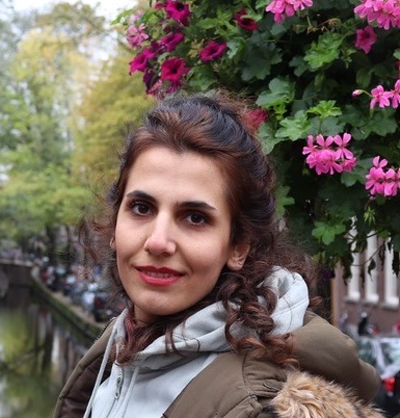Modeling the effect of retained austenite in forming of TRIP-aided dual phase steel
Shahrzad Mirhosseini is a PhD student in the Department of Nonlinear Solid Mechanics. (Co)Promotors are prof.dr.ir. A.H. van den Boogaard and dr. E.H. Atzema from the faculty of Engineering Technology.
 Transformation-induced plasticity (TRIP)-aided steels are a special type of advanced high-strength steels (AHSS) that play a critical role in the automotive industry. These type of steels stand out due to their unique mechanical properties such as enhanced strength, hardening, ductility and high energy absorption that makes them valuable in vehicle safety and crashworthiness. They owe their improved characteristics to the transformation-induced plasticity phenomenon. This means that they undergo a phase transformation during mechanical loading that introduces an extra plastic strain and shifts their strength and hardening both significantly.
Transformation-induced plasticity (TRIP)-aided steels are a special type of advanced high-strength steels (AHSS) that play a critical role in the automotive industry. These type of steels stand out due to their unique mechanical properties such as enhanced strength, hardening, ductility and high energy absorption that makes them valuable in vehicle safety and crashworthiness. They owe their improved characteristics to the transformation-induced plasticity phenomenon. This means that they undergo a phase transformation during mechanical loading that introduces an extra plastic strain and shifts their strength and hardening both significantly.
Mechanically-induced martensitic transformation of retained austenite is a complicated phenomenon to be described precisely. Although there are several theories to explain the kinetics of martensitic phase transformation, the lack of a physically-based predictive model adds to the complexities of using TRIP-aided steel in industry. One of the most prominent theories that explain the martensitic transformation mechanism is based on the driving force for transformation and the stress concentrated in the austenite phase. TRIP-aided steels are multiphase materials that combine several phases: ferrite, austenite and usually martensite. These constituent phases introduce a heterogeneous microstructure with a soft ferritic matrix and a hard martensitic phase. This wide range of variation in mechanical properties in the microstructure necessitates a model that can predict the material response and the stress concentrated in each phase. The choice of an appropriate homogenization model is a trade-off between accuracy and computational efficiency. Moreover, the resulting model should be very efficient computationally to enable application in the analysis of forming processes, hence the choice to employ a homogenized model. Mean-field homogenization is a well-known model that is founded on the basis of averaging of stress and strain fields. This reduces the computation time significantly compared to the computation of the complete heterogeneity of stresses and strains. Mean-field models have proved to present acceptable predictions of the mechanical response of multiphase materials while being beneficial in terms of computational costs.
In this project, a mean-field-based phase transformation model is developed based on which for a specific loading path, the averaged stress and strain concentration in each phase is predicted. Using a criterion for phase transformation that is defined as a function of the free energy of austenite and martensite phase, the initiation and evolution of martensitic transformation is captured. Several parameters have been observed to have a crucial influence on martensitic transformation, such as temperature, chemical composition and grain size. The effect of these parameters on phase transformation is modeled in this project.
Temperature rise suppresses martensitic transformation and postpones its starting point. This delay in martensitic transformation is not always a favorable behavior. Retained austenite in TRIP-aided steels is desired to transform at room temperature during mechanical loading. Once transformation sets in, the strength and hardening of the material is enhanced. Hence, a highly stable retained austenite may deteriorate the expected material response.
The presence of some alloying elements, such as manganese and silicon, may also stabilize the retained austenite. The influence of these two parameters on the material strength and diffuse necking point is investigated in this study. It is also well-known that the grain size distribution over the microstructure of TRIP-aided steels is not uniform and not all austenite grains are of the same grain size. This necessitates a numerical framework that includes the effect of the austenite grain size.
Beside mean-field homogenization, full-field models are used as a numerical tool to assess the microscopic material response. Full-field models, unlike mean-field models compute the local distributions of the fields. Despite presenting accurate results, full-field models are computationally extremely costly which makes their use a challenge in industrial applications. Crystal plasticity finite element (CPFE) analysis is an extensively used model at the grain scale for steel (microscale). To use a mean-field-based phase transformation model in industrial applications, its accuracy in comparison to CPFE simulations needs to be evaluated. In this thesis, a comparison is made between the stress-strain results obtained by mean-field and CPFE-based models for the case of homogenized behavior of TRIP-aided steels. To reach this goal, the CPFE simulations over representative volume elements (RVEs) are extended to the definition of periodic boundary conditions on arbitrarily-shaped 3D periodic RVEs. In these finite element simulations, an in-house rate-independent crystal plasticity model is used as the subroutine at each integration point. In the mean-field model, Von-Mises and Hershey yield surfaces are used. To reach quadratic convergence in solving the constitutive model of phases, a closed-form derivation for the Hershey yield surface is presented, which is one of the novelties of the current work. The results of this comparison show the potentials and limitations of mean-field model in prediction of mechanically-induced martensitic phase transformation.
One of the main challenges in the application of TRIP-aided steels is the prediction of their performance in sheet metal forming processes. In this project, a forming process is simulated in Abaqus/Standard using the developed mean-field approach to predict the distribution of martensitic transformation over various sheet sections that experience various loading conditions and stress states.

